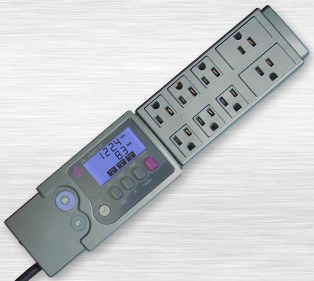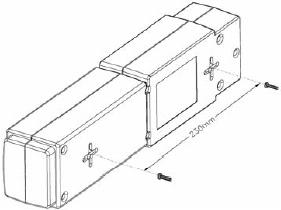P3 Kill a Watt PS P4320
P3 Kill A Watt PS P4320
Find out more about the Kill-a-Watt Power Strip P4320
home > energy efficiency | electronics | generalIn our article Kill-a-Watt we looked at the plug-in electricity usage monitor of that name. Still not available for the UK market, we also introduced a UK Power Meter which does the same job - displaying how much power any appliance plugged into it is using.

New from P3 International is the Kill a Watt PS (P4320) - an electricity usage monitoring power strip (pictured above). This new product offers a selection of advanced features designed to protect expensive electronic equipment at the same time as measuring its power usage.
Power Strip Features
The power strip offers 8 outlets in total - 6 of standard width, and 2 extra wide outlets to enable mains transformers to be plugged in (for use with mobile phones, battery chargers, and so on). The power strip is fitted with a 2 metre (6 feet) long cable and a low profile plug.To protect senstive electronics from voltage spikes when they are plugged in, a spike-free ON/OFF switch offering soft power-up is integrated in the Kill-a-Watt PS. Advanced surge protection circuitry is coupled with an EMI (electro-magnetic interference) filter to ensure that only clean, safe power gets to your appliances. Over-current, over-voltage, and over-load detection gives further protection.
A Max Amps switch enables the user to set the maximum current which the appliances plugged into it can draw - 2A, 5A, 10A, or (by default) 15A. If the plugged in appliances attempt to draw more current than the Max Amps settings, an electronic fuse breaker (NFB) will cut power to all of the outlets.

The power strip can be wall mounted (using 2 no. 8 sized screws).
Electricity Usage Monitoring Features
The Kill-a-Watt PS tracks 8 key measurements - voltage, line frequency, current, active power, power factor, cumulative kWh, current leakage, and elapsed time. It will also calculate the cumulative cost of the electicity used since your last reset, and forecast the cost per day, week, month, and year of electricity at current usage levels.If you remove power from the Kill-a-Watt PS, all accumulated measurements (kWh and elapsed time) will be stored in memory ready to be added to when the unit is plugged back in again. At that time, the display flashes to indicate that there has been a power interruption - useful to know in the event of a brief power cut.
Buying the Kill-a-Watt PS
The Kill-a-Watt PS (P4320) is available online in the USA for just under US$100. As with the standard Kill-a-Watt, the maximum input voltage is 120 VAC (for the US 110 VAC mains supply) - therefore, this product cannot be used in the UK, Europe, Australia, NZ, Far East etc.However, a standard 240VAC rated UK Power Meter (<£20) can be used in conjunction with a good quality standard surge-protection power strip / extension cable (<£20) to emulate most of the functionality of the P4320.
More Information
For more information about this product, click here to read the Kill-a-Watt Power Strip operating manual (PDF), and here it view the product brochure (PDF). Click here to visit the P3 International official website to find out about the other products they sell.Comment on this Article
If you have any comments on this article, please email them to neil@reuk.co.uk.Related Articles
Click one of the links below for further articles on the following relevant topics:energy efficiency, electronics, general.